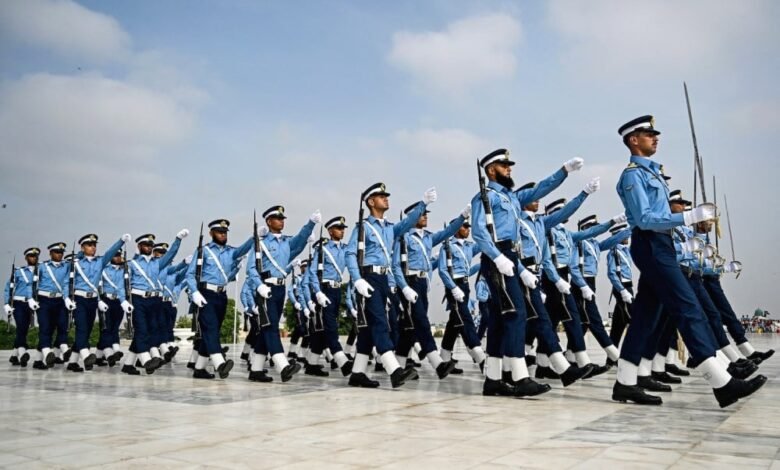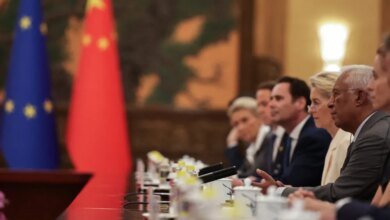India Faces Down New Security Calculus – Foreign Policy

The announcement of a comprehensive defense agreement between Pakistan and Saudi Arabia last month represents more than just another bilateral agreement in a complex regional security matrix.
The deal was framed as a response to rising insecurity in the Gulf amid unrestrained Israeli military postures in Lebanon, Syria and the broader Middle East. But beneath the surface, the implications of the new defense agreement are much broader. It changes Pakistan’s strategic position, deepens the defense entanglement between Riyadh and Islamabad, and fundamentally complicates India’s policy in its own backyard.
After nearly a decade of diplomatic maneuvers aimed at isolating Pakistan internationally, Indian Prime Minister Narendra Modi faces a structural realignment that is entrenching New Delhi’s rival not only in West Asia – historically a theater of Indian economic influence – but also in the geopolitical imagination. The Saudi guarantee gives Pakistan new legitimacy, creating ripple effects extending from the military balance in the Indian subcontinent to narrative politics in the Islamic world.
The new agreement represents more than just a one-time security arrangement, and Pakistan is the clearest beneficiary of the formalized partnership. For India, this poses immediate military risks and lasting diplomatic challenges. How New Delhi responds — whether through tactical adjustments or fundamental policy resets — will determine whether this development represents a temporary setback or a more permanent shift in the strategic landscape.
New defense agreement It gives Pakistan immediate and significant gains. Besides the obvious financial benefits of Saudi financing of military modernization, it provides the diplomatic insurance that Pakistan has lacked since the end of the Cold War. Islamabad now enjoys the support of the most influential power in the Arab world, a country with economic influence that extends far beyond the Middle East.
Not only would Pakistan be encouraged, but a formal partnership would constrain international responses to a future crisis such as the military conflict that erupted with India in May, making it difficult for New Delhi to mobilize global support.
Perhaps more importantly, this arrangement gives Pakistan indirect access to advanced Western military technologies that flow through Saudi channels; Riyadh is considered the preferred customer for the American and European defense industries. These systems include systems that mirror parts of India’s own arsenal, which could narrow capability gaps. The irony is stark: Indian military planners have spent years calculating the advantages over Pakistani forces, and now must take into account Saudi-funded improvements to their adversaries’ capabilities.
The general nature of the defense agreement also constitutes a vote of confidence in the professionalism, capabilities, and strategic competence of the Pakistani military establishment. In the wake of the Indo-Pakistani conflict in May, Saudi Arabia provided critical international validation to Pakistani military commanders, undermining India’s claims that it had humiliated its rival militarily this year.
There is also the nuclear dimension. By expanding the umbrella of deterrence to include Saudi Arabia, Pakistan is transforming its nuclear program from a regional equalizer into an instrument of broader geopolitical influence. Saudi Arabia will transform from a passive investor to an active stakeholder in the survival and credibility of the Pakistani arsenal. This creates incentives for Riyadh to support Islamabad’s nuclear modernization efforts, which could accelerate developments that could change the strategic balance in the Indian subcontinent.
The agreement also changes the basic logic of strategic stability in Islamabad, as its nuclear weapons are no longer limited to India, but have become part of broader deterrence calculations within the Islamic world. It is also possible that Pakistan’s nuclear strategy could serve as a security guarantee for other Muslim-majority countries, placing them within a broader context of interests and alliances. In this way, Pakistan’s nuclear posture is now influenced by broader geostrategic calculations that go beyond its competition with India. For New Delhi, this makes the already volatile nuclear equation in South Asia even more unstable.
Beyond military considerations, the defense agreement with Saudi Arabia represents a diplomatic revolution for Pakistan. After years of international isolation, Islamabad suddenly found itself elevated to the status of declared protector of Islam’s two holy mosques, Mecca and Medina. This symbolism serves a dual purpose. It reinforces the core domestic narrative of the Pakistani military – that it is the ultimate guardian of the nation and Islam, especially in times of crisis – as the country faces deep political fissures and economic conflicts. Externally, this amplifies Pakistan’s claim to be an indispensable power to the Islamic world.
For India, the optics are harmful. For many years, Pakistan’s standing in the Islamic world has been declining. Türkiye has sought to challenge its leadership role, countries like Iran and Qatar have pursued competing visions of Islamic leadership, identity, and narratives, and countries like the United Arab Emirates have moved toward deeper trade and security ties with India. New Delhi has sought to take advantage of this fragmentation.
Through economic clout, security partnerships, and skillful narrative management, India has long succeeded in portraying Pakistan as an unstable, terrorist-supporting state undeserving of serious international engagement. The partnership with Saudi Arabia shatters Modi’s carefully crafted narrative. Now, Pakistan finds itself back at the table as a partner of consequence.
However, it would be wrong to interpret the strategic agreement between Saudi Arabia and Pakistan as limitless. Both countries face restrictions that reduce the scope and functionality of the partnership.
The Pakistani army remains exhausted, facing multiple insurgencies across its tribal areas in Balochistan and Khyber Pakhtunkhwa provinces, while also maintaining its readiness along its borders with India and Afghanistan. This leaves few reserves available for major military commitments in the Gulf region. Pakistan’s economic weakness also threatens to undermine its ambitions. Even with Saudi support, sustainable modernization requires local technological depth; Pakistan remains highly dependent on China.
Despite their credibility, Pakistan’s nuclear capabilities are also limited in scope and complexity compared to those of more established nuclear powers. It cannot be extended credibly without exposing internal weaknesses. Doing so would strain Pakistan’s command structure, perhaps exposing weaknesses in communications systems, decision-making protocols, and multi-layered authorization processes. It will also increase the movement and handling of sensitive materials. Moreover, political instability continues to plague Islamabad, raising questions about its long-term strategic coherence.
Saudi Arabia has its own restrictions. India remains a vital economic and energy partner, and millions of Indian workers in the Gulf contribute to the Saudi economy. The Kingdom’s deep economic and security ties with New Delhi motivate it not to take any actions that could fundamentally harm bilateral relations. This means that Saudi Arabia will carefully calibrate the partnership with Pakistan, avoiding any direct confrontation with India. In any case, Saudi priorities remain focused on Iran and regional stability, and not on the conflict in South Asia.
Saudi Arabia’s simultaneous outreach to Iran through Chinese-brokered diplomacy reflects the contradictions in its security strategy. Hedging against Israel, building bridges with Iran, and empowering Pakistan while cultivating lucrative relations with India creates a complex web of conflicting incentives for Saudi Arabia. These contradictions will inevitably limit operational cooperation between Riyadh and Islamabad.
Ultimately, the practical impact of the Saudi-Pakistani defense agreement may be more modest than initial assessments suggest. Pakistan has a well-documented history of overuse of force, from its relationship with the United States during the Soviet occupation of Afghanistan to its early partnership with China. The relationship with Saudi Arabia could follow similar patterns if Pakistani decision makers miss the mark on tactical gains and key strategic advantages.
However, India cannot afford a military base Its strategic thinking about the folly of its opponents, and the security agreement between Saudi Arabia and Pakistan, has created new calculations by which New Delhi must act. More directly, this complicates India’s relationship with Saudi Arabia, which has deepened significantly in the past decade through energy partnerships, investment agreements, and security cooperation. Riyadh now finds itself managing its relations with two nuclear-armed rivals.
This dynamic threatens to reintegrate India and Pakistan into international discourse, or to link their relationship in a way that forces third parties to deal with them as interconnected rather than as two separate strategic entities. For Indian policymakers who have worked tirelessly to establish India as a rising power independent of its neighbor and rival, this represents a major setback.
The last three military conflicts between India and Pakistan – in 2016, 2019 and this year – were all sparked by violent incidents in Kashmir. Saudi Arabia has engaged in de-escalation efforts during these crises, but public investment in Pakistani stability and security could provide Riyadh with the incentive and leverage to involve itself in resolving the Kashmir dispute.
The possibility of third-party involvement in Kashmir, which Indian policymakers have long viewed as a red line, becomes a major headache for New Delhi when Islamabad’s new strategic partner has compelling interests in regional stability.
India now faces a more dangerous opponent. With enhanced financial resources, indirect access to Western weapons, and Saudi diplomatic support, Pakistan’s military posture vis-à-vis India will harden. Even if the partnership with Saudi Arabia fails to achieve full operational conditions, its impact changes the deterrence landscape. India now faces a Pakistan fully backed by China, strategically backed by Saudi Arabia, and benefiting from new American generosity under president Donald Trump.
This alignment is reshaping the strategic environment in South Asia in a way that New Delhi did not expect, and the uncomfortable truth is that it entered this impasse while asleep. Modi’s foreign policy priorities, which revolve around showmanship with leaders like Trump, Israeli Prime Minister Benjamin Netanyahu, and Saudi Crown Prince Mohammed bin Salman, may be inappropriate for the current geopolitical moment.
The emphasis on personality and leader-leader relationships produced short-term gains but also created weaknesses. India now needs a new strategic imagination that recognizes that the emerging lines of regional alliances are being shaped not in New Delhi, but in Riyadh, Islamabad, and Beijing.
Doubling down on rhetoric about Pakistan’s global isolation serves little in a changing landscape. Instead, India must develop ideas and leaders who can formulate policies that avoid the traps of the past decade. These factors include over-reliance on Western leniency, underestimation of Pakistan’s resilience, and arrogance about its global rise that rests solely on Modi’s strength of character.
India’s path forward requires abandoning the comfortable certainties that have characterized the Modi era and embracing the uncomfortable reality that regional power is increasingly determined not by New Delhi’s aspirations, but by the strategic choices of its adversaries.
Don’t miss more hot News like this! Click here to discover the latest in Politics news!
2025-10-09 11:00:00




